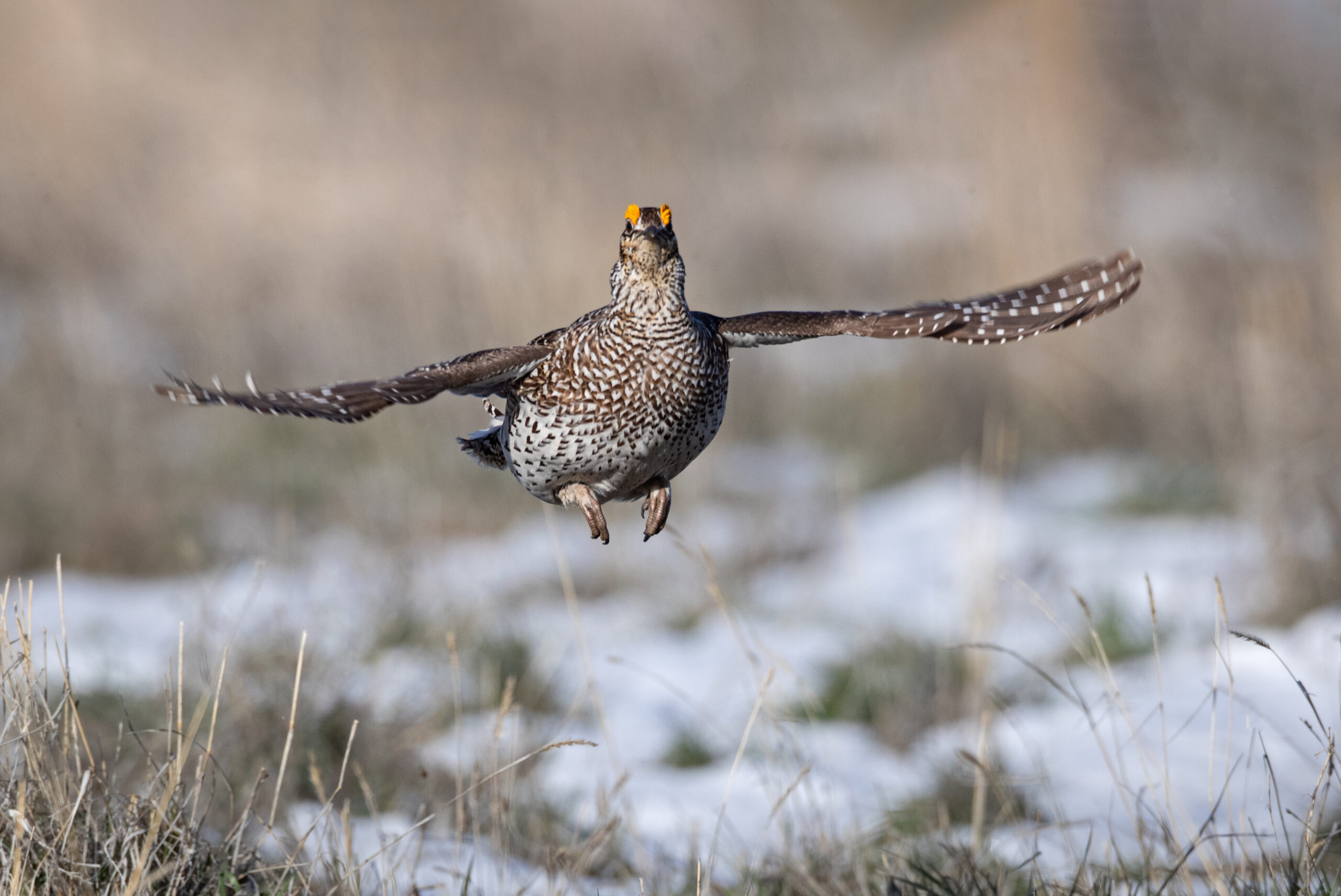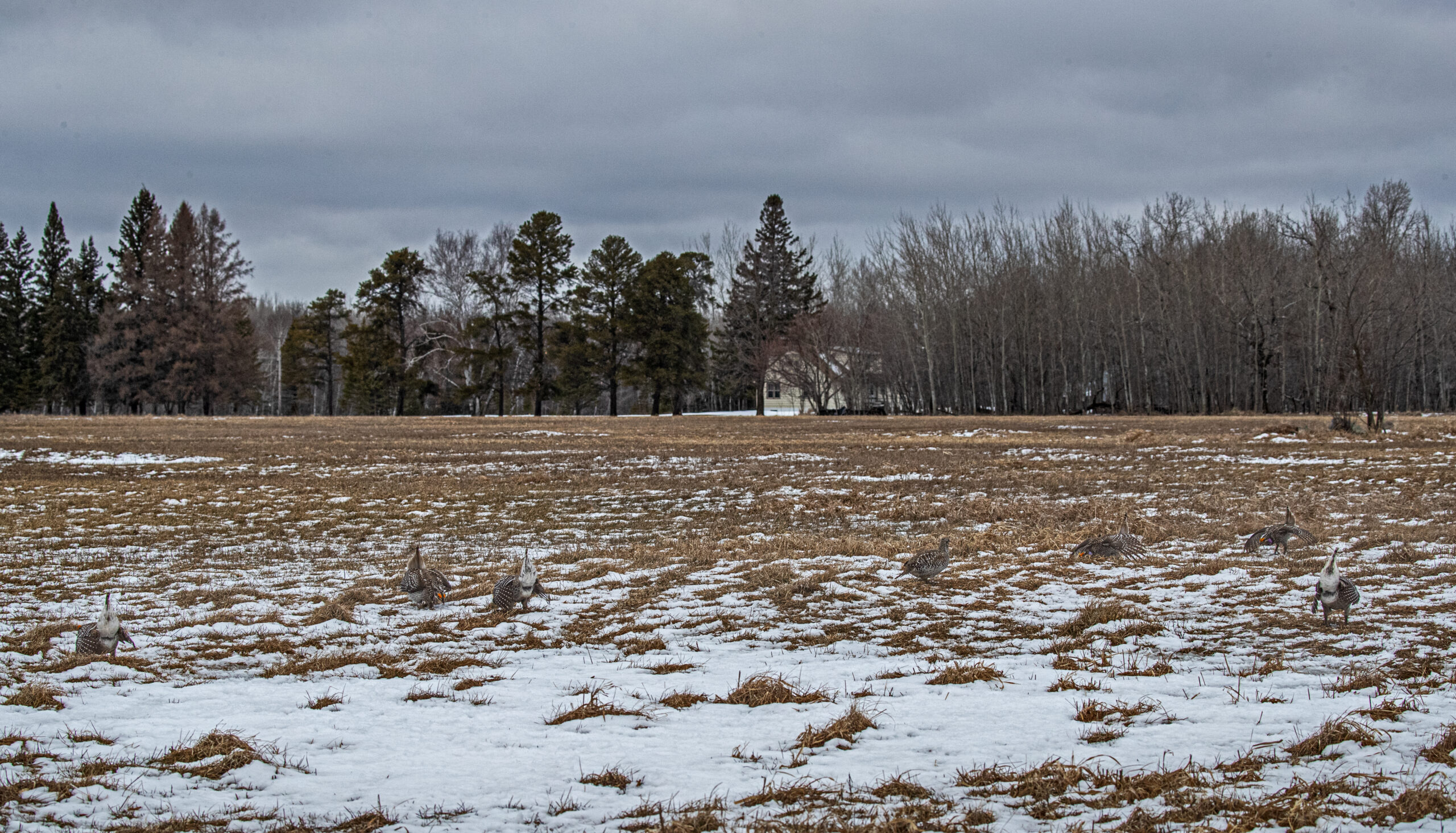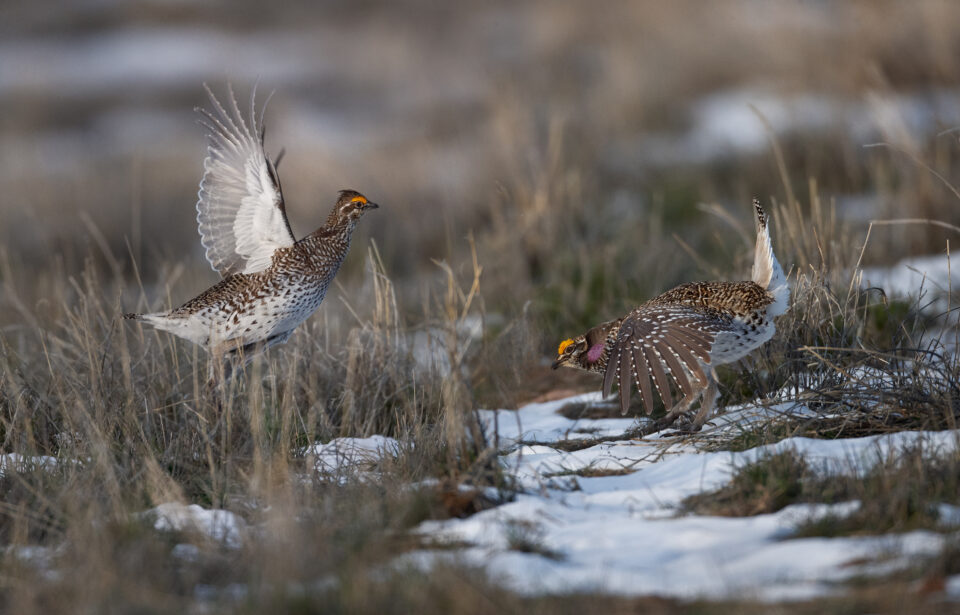In Search of the Firebird
It’s late April on the U.S.-Canada border, pitch-black in the hour before dawn. Snow comes down sideways, making Minnesota State Highway 11 out of Baudette almost invisible from our SUV. We’re following the ghostly lights of another vehicle; at the wheel is Scott Laudenslager, a supervisory wildlife biologist at the Minnesota Department of Natural Resources (DNR). He’s leading us on a wild grouse chase.
A few miles farther along, we turn and rattle our way down a deserted, ice-and-snow-rutted side road that seems to go on forever. But that remoteness is how our quarry prefers it. We’re in search of the “fire grouse,” perhaps better-known as the sharp-tailed grouse (Tympanuchus phasianellus). To Native Americans of the northern prairies, the sharp-tailed grouse was pheta silo (Sioux) or ishkode mitchihess (Ojibway)—firebird—for the need for fire to keep its grassland habitat open.
Laudenslager skids to a stop. We’re a few yards behind him. Doors silently open, and we’re soon crunching our way 100 yards down a slippery trail across a field, flashlights off. Just visible in the dark is a small hut, a blind with openings for binoculars and cameras. We enter through a door in the back, to find slats looking out on a small, snow-dusted circle in the field. “We need to be very quiet,” whispers Laudenslager, whose DNR office in Baudette manages the blind. “This is the dancing ground, or lek, of the sharp-tailed grouse.”
The “hide,” as some refer to it, is about 20 minutes south of Baudette, and may be reserved to view the sharp-tailed lek. It accommodates three people, has chairs with cushions and is set up for photography. Viewers have the sun at their backs for the best photographic conditions, according to Laudenslager, who says that “the sharp-tails dance right in plain sight.”
As if on cue, soft noises drift across the grassland. It’s still almost an hour before sunrise, but male grouse have already started advertising for females. They’re making grouse mating music, which scientists call cackling, and will soon start flutter-jumping, movements that look exactly like they sound. “Signals that serve primarily to advertise the location of the dancing ground and of specific males include the flutter-jump and cackling calls,” writes Paul Johnsgard in The North American Grouse: Their Biology and Behavior. “Both sexes perform cackling calls. Cackling by females is usually performed as they approach the dancing ground, and this stimulates strong responses by the males, especially flutter-jumping.”

In flutter-jumping, according to Johnsgard, “the male jumps into the air a few feet, uttering a chilk note as he takes off, flies a few feet forward, and lands again.” He’s showing off for any nearby females. But “the most complex and interesting of the male displays,” observes Johnsgard, “is the ‘tail-rattling’ or dancing display.” Rapid stepping movements—18 to 19 per second—result in the bird moving forward in a curve, something like a tiny wind-up plane. At the same time, the male vibrates his tail from side to side, producing a rattling sound.
Rattling just outside alerts us that sharp-tails are indeed performing, even in the dark. Laudenslager estimates that about 18 sharp-tailed grouse are mere feet from the blind. The fire grouse, found.
In his Life Histories of North American Gallinaceous Birds, Arthur Cleveland Bent quotes one D.G. Elliot, who in 1897 described the dancing. “In the early spring, in the month of April, when perhaps in many parts of their habitat in northern regions the snow still remains upon the ground, the birds, both males and females, assemble at some favorite place just as day is breaking, to go through a performance as curious as it is eccentric.
“As the ‘dance’ proceeds,” continues Elliot, “the excitement of the birds increases, and they twist and turn, leaping over each other in their frenzy. As the sun gets well above the horizon, and night’s shadows have all been hurried away, the antics of the birds cease, and the grouse scatter in search of food.” At the Baudette lek, the sun rises and the birds indeed wander off, pecking at the ground and nibbling on whatever grain and buds they find.
Prairie Grouse without a Prairie
Flocks of sharp-tailed grouse were once so large pioneers said they blocked the sun. But as Minnesota’s—and other northern prairie states’—grasslands and brushlands disappeared, with them went sharp-tailed grouse.
At one time, Native Americans performed a “circle dance” with origins in prairie grouse behavior, “and pioneers waded through a sea of grasslands and shrublands feeding on prairie grouse, but neither could have imagined the day when so few would remain,” states Saving Wide Open Spaces for the Firebird, a Minnesota sharp-tailed grouse management plan for 2022-2032. The report was drafted by Jodie Provost and other members of the Minnesota Sharp-tailed Grouse Society.

Sharp-tailed grouse inhabit the pine savannas of the eastern upper Midwest across to the short grass, mid-grass, and shrub steppe prairies of the Great Plains and Rocky Mountain West. Their preferred habitats are savanna-like prairies with grasses dominant and shrubs mixed in, and few patches of trees.
In Minnesota, the sharp-tail’s range is restricted to the northwestern and east-central parts of the state. “Our sharp-tail population has declined greatly in the last 50 years,” says Laudenslager. “But controlled burning and tree-clearing have helped prevent some open brushlands and grasslands from turning into woodlands.”
The expansive open landscapes needed by sharp-tailed grouse were once a conspicuous feature of Minnesota. Based on a pre-settlement vegetation map, states Saving Wide Open Spaces, “11.3 million acres, or more than one-third, of the state’s northern and central forest and transition region was brushy prairie, oak barrens, jack pine barrens, conifer bogs and swamps, and muskeg.” Small-scale farming and logging created more sharp-tail habitat, and large wildfires such as the Hinckley Fire of 1894 and Cloquet Fire of 1918 burned dense woodlands and turned them into open fields and prairies—for a time.
Based on 1990s land use and cover information, only 1.3 million acres (4 percent) of these northern and central regions of Minnesota were still brushland. “We’ve known for some time that in the east-central region, large, open areas of grassland and brushland are changing and becoming less suitable,” says Charlotte Roy, the DNR’s grouse biologist.
Challenges Ahead for Firebirds and Kin
Degradation and loss of the expansive habitats sharp-tails need are largely a result of suppression of wildfires that clear the land of vegetation, and a lack of sufficient prescribed burning to keep them open. Also playing a role: conversion of grasslands to croplands; the heavy rains of climate change; and the decline of small-scale farms and livestock producers and therefore loss of small grains, pastures, and hay lands. Planting cover crops, rotational grazing, delayed haying, and creating buffer strips can provide more sharp-tail habitat.

“Sharp-tailed grouse can pioneer new suitable habitats,” states Saving Wide Open Spaces, “when source populations and adequate connecting habitats exist in proximity.”
Sharp-tailed grouse—and related prairie chickens—are classified as Species in Greatest Conservation Need in Minnesota. That said, hybridization between these species is occurring, according to Roy, and researchers have observed more sharp-tailed grouse and hybrid birds at prairie chicken booming grounds in recent years. As production of hybrid offspring increases, the gene pools of these species mix and the number of pure prairie chicken and sharptail chicks is reduced.
To learn more, Roy and other scientists are studying prairie chicken and sharp-tailed grouse wings and tail feathers collected from birds harvested by hunters. “Information from the feathers will help prairie chicken and sharp-tailed grouse management, with the goal that populations of these species stay at their current levels or increase,” says Roy.
Provost says that “no more charismatic species than these exist to inspire efforts to save wide open spaces.” Laudenslager agrees. “Sharp-tails have gathered at the lek near Baudette for at least a dozen years and likely much longer. I hope they’ll be there, doing their spring dance, decades from now.”
Photography by Ilya Raskin




